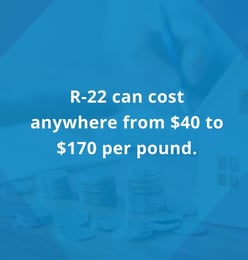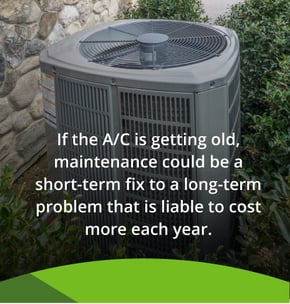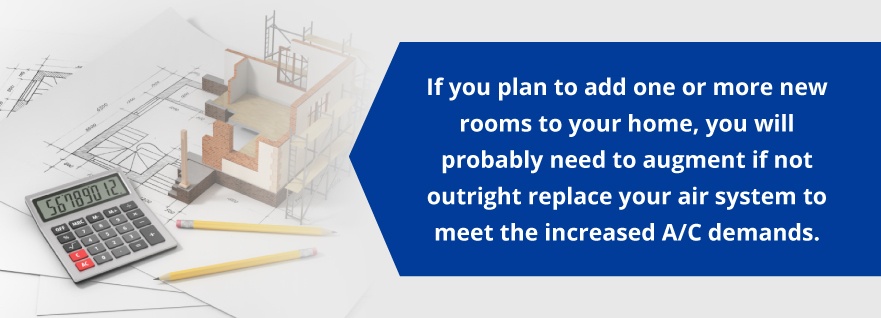
When is it necessary to replace an A/C system? It really depends on the age of the A/C and its current condition. The time when it is best to replace an air conditioner depends on how many years have passed since the original installation date and whether it would cost less to repair or replace the A/C system. To determine when it would be best to replace your central air system, consider the options in the scenarios covered in this article.
The A/C Was Installed More Than 10–15 Years Ago
Air conditioners are not built to last forever. In fact, an A/C will last the same amount of time as the average residential occupancy — roughly 10–15 years. Beyond that point, an A/C system is liable to show an increased number of problem symptoms that can lead to costly repairs. As these problems become more frequent, the more economical choice might simply be to replace the central air system.

One of the biggest red flags of a faltering A/C system is when it requires some major set of repairs merely one year after you last had the unit serviced. If you sank several hundred dollars into your central air system last summer and now it is already failing, chances are this will be an ongoing pattern at the start of every warm season.
Regarding the age of the A/C, the decision on whether to repair or replace the system should be considered as follows:
- Repair: If the air conditioner is less than 10 years old, it is generally best to have the system serviced when the system shows signs of inefficiency or dysfunction.
- Replace: If the system is more than a decade old, the A/C is likely living on borrowed time. Even when you have it fixed, it will probably display more issues just a few years down the line. If the A/C is more than 15 years old, it would probably be better to replace the unit.
Basically, if an A/C hasn't reached its full life expectancy, do what it takes to keep the unit in good working condition. If the A/C has exceeded its life expectancy, it's probably time to get it replaced.
The 5,000 Rule
When it comes to comparing the respective costs of A/C repairs versus a new air system, apply the 5,000 Rule, which works as follows:
- Take the total cost of repairs and multiply that number by the age of your current system.
- If the total exceeds the average cost of a new system ($5,000), a replacement would be your best option.
- If the total falls under that amount, have the system repaired instead.

Consider the situation of a 10-year-old system that needs $450 in repairs. Going by the 5,000 rule, the system in question is worth having maintained because the repair costs multiplied — $450 x 10 = $4,500 — won't exceed the threshold.
Basically, an air system that can be repaired for less than the cost of a new one will likely have enough life ahead of itself to merit the price of repairs. By contrast, a faulty system that exceeds the 5,000 Rule is liable to cause further costly problems in the years ahead because the A/C is already on borrowed time.
The System Uses R-22 Refrigerant
When refrigerant must be replaced, the issue is usually symptomatic of a coolant leak, which is a serious problem for any A/C unit. On older air conditioners, R-22 — alternately known as Freon — is the refrigerant used to condition air at desired temperatures of coolness. The trouble is, R-22 is being phased out by manufacturers due to its emission levels and is, therefore, more costly to replace in ailing units.

R-22 can cost anywhere from $40 to $170 per pound. When you multiply those figures several times and add the cost of leak repairs, the price for new R-22 refrigerant could spiral into the $550–$1,000 ballpark. Currently, the high cost of R-22 replacement is due to its reduced production, which will stop entirely in 2020. Consider the following options accordingly:
- Repair: If the A/C system was installed in the late 2000s and uses R-22 — manufacturers stopped producing Freon-based systems in 2010 — and the cost of repairs falls under the $5,000 threshold, you might be able to get another half-dozen-years worth of performance from the A/C with new refrigerant.
- Replace: If the A/C is already on borrowed time, your best option is to replace the system. R-22 could be a pricey investment for an old system that is liable to have numerous other issues in the upcoming years.
To reduce carbon emissions and render A/C systems more efficient, newer A/C systems use R-410A — a longer-lasting and environmentally-friendlier alternative to R-22.
Heating and Cooling Bills Are Getting Steeper
Heating and cooling costs are liable to fluctuate year-to-year as weather patterns change and electric companies charge more for their services. That said, you can tell that something is up with your energy consumption if you see uncharacteristic spikes from one month to the next in your energy bills.

If the difference between May and June is a $20 jump in your energy bill — as opposed to the typical $5 increase between spring and summer — you are probably consuming too much energy. The question is how. If you continue to make sensible use of your air system and costs continue to rise despite there being no announcement of a rate increase or any serious changes over the prior year's seasonal weather patterns, the problem is likely due to your air system.
When an air system consumes too much energy, the problem is usually due to failing mechanisms that struggle to perform the same basic functions that they once did effortlessly. Consequently, the A/C strains and consumes more energy to provide sufficient coolness. If your energy bills have spiked due to A/C performance, consider the options as follows:
- Repair: If the system has not surpassed its lifecycle and falls well under the 5,000 threshold, have the A/C repaired.
- Replace: If the system is on borrowed time and approaches the 5,000 threshold, the added energy costs and inevitable future performance problems are liable to be costlier than a new A/C system.
Conclusion – soaring energy costs can add up over the course of a year. When combined with the periodic repairs that older air systems require, a new A/C could be a bargain by comparison.
The A/C Seems Less and Less Effective
When you first experience the comforts of an A/C system, the difference it makes to the humid ambient air is like night and day, especially if you have previously had to cope with exceedingly hot conditions. As time goes on and you grow accustomed to the adjusted indoor temperatures, the feeling becomes second nature. Consequently, you might be slow to notice if the air system gradually loses its effectiveness.
 If the A/C seems less powerful than it did the prior summer, despite this year's local temperatures being identical or slightly lower than they had been 12 months earlier, your air system could be losing its power. If the situation has gotten worse for two years running and you now find yourself sweating despite keeping the A/C going non-stop, the system needs maintenance. Consider the options as follows:
If the A/C seems less powerful than it did the prior summer, despite this year's local temperatures being identical or slightly lower than they had been 12 months earlier, your air system could be losing its power. If the situation has gotten worse for two years running and you now find yourself sweating despite keeping the A/C going non-stop, the system needs maintenance. Consider the options as follows:
- Repair: If the system has yet to reach its sell-by date, consider this a simple maintenance investment.
- Replace: If the A/C is getting old, maintenance could be a short-term fix to a long-term problem that is liable to cost more each year.
Remember, there is a difference between a faulty A/C and a failing A/C.
Repairs Are Needed More Frequently
If you have had the same air system for more than a decade, you might have had the system serviced two or three times over the years. If you suddenly need to have it serviced again just months after the last round of maintenance, that is an indicator that the A/C is in for greater problems.
All A/C systems give out eventually, the question is when. With some systems, responsible upkeep and periodic maintenance can keep the A/C running well past its life expectancy. Usually, maintenance is more of a patch than a cure once the system has exceeded its full life expectancy. If the system now requires frequent repairs, such work is liable to be a drain on your wallet that won't pay off in the long run. Consider the options as follows:
- Repair: If the system is young and it needs a second or third round of repairs in the space of a year or two, consider having the A/C inspected by a different service specialist. Possibly, the system's performance issues were not properly diagnosed the first time.
- Replace: If the system is old and repairs have become an annual or biannual necessity, the money you are liable to spend in a year just to keep the A/C running could well exceed the 5,000 threshold.
Back-to-back A/C problems could mean one of two things — the system wasn't thoroughly diagnosed and repaired the first time or it's approaching the end of its lifespan.
The Unit Makes Strange Noises
When strange noises come from unexpected sources, it should often be taken as a warning. Just as odd noises from your car's engine should serve as a red flag, so too should unusual sounds from your air system.

If the air conditioner makes excessive noise, the issue could stem from an insufficient duct system. In large houses, this often boils down to the size of the air system in relation to the dimensions of the house. Simply put, an A/C is liable to make noise if the duct system is too small for a house's interior square footage.
Alternately, the noise could stem from an issue with the system's indoor coil. In the case of A/C noise, consider your options as follows:
- Repair: If the air system is fairly new, an investment in the matter could preserve the A/C for a number of years to come.
- Replace: If the A/C is already more than 10 years old and the problem is due to a disproportionate duct system, the 5,000 rule is likely to favor an investment in a new air system.
In any case, loud and strange noises from an air system should always be taken seriously.
Your House Accumulates More Dust
Most people wouldn't correlate the presence of excess dust with A/C issues. However, dust buildup can, in fact, result from problems with the ductwork. If your household fixtures and furnishings have been accumulating dust at greater frequencies than before, the problem could stem from leaks in the duct system.
Once the ducts develop leaks, efficiency is lost from the air system because the A/C is forced to strain itself to maintain sufficient levels of coolness. If the problem continues unchecked, your energy bills are liable to rise — another indicator that something is wrong with the A/C.
If frequent dusting has all been in vain and the air system also exhibits other issues that typically stem from faulty ducts — noise, insufficient coolness, etc. — consider your options as follows:
- Repair: As always, an air system that is less than 10 years old should be inspected for duct leaks and repaired in the likelihood that cost estimates don't exceed the 5,000 threshold.
- Replace: With older air systems, leaky ducts are as good an indicator as any that the time has come to invest in a new A/C.
Rule of thumb — an A/C is built to produce cool air, not dust.
Summers Are Getting Hotter and Hotter
As a consequence of climate change, extreme temperatures at both ends of the spectrum have been experienced throughout much of the world. Across the United States, residents have been faced with hotter summers and colder, harsher winters. Consequently, people are leaning much more heavily on their air systems to combat July/August conditions in excess of 100°F.
If the summers have gotten progressively hotter in your area over the past several years, increased demands have likely been placed on your air conditioner. To maintain peak performance, the A/C must be up-to-date and proportional to the interior dimensions of your house. Otherwise, the air system is liable to exhibit performance issues.
If summer temperature patterns have intensified at the expense of your air system, consider your options as follows:
- Repair: If the system is less than a decade old and, better yet, utilizes R-410A refrigerant, invest in maintenance to keep the A/C running through the next several spring/summer seasons.
- Replace: If the A/C is approaching the 10th anniversary of its installation and uses outdated R-22 refrigerant, consider investing in a more robust air system.

Remember, an air system that kept you comfortable when local temperatures peaked in the 80°F to 90°F range will have to exert more power to remain effective if temperature peaks shift to the 90°F to 100°F range.
You Live in a Hot Climate
Perhaps you live in a climate where temperatures remain in excess of 75°F for much lengthier stretches of a given year. If the weather in your area typically soars into sunny warmth by mid-March and doesn't let up until mid-October, you probably rely on your air conditioner twice as much as residents in more northern areas.
In hotter climates, air systems face greater demands and must be equipped to meet these challenges. If you ultimately need to use your A/C six or seven months out of the year instead of three or four, you are liable to run into performance issues sooner and possibly at greater frequencies unless the system is equipped for more intensive usage.
If lengthier-than-average usage cycles have taken a toll on your air system, consider your options as follows:
- Repair: A newer system with R-410A refrigerant is better equipped for lengthier usage cycles over the course of a given year and should, therefore, undergo maintenance to ensure a maximum lifecycle.
- Replace: An older air system with outdated refrigerant could wear out more quickly in a hotter climate with lengthier spring/summer seasons. As such, investing in a new A/C could save you money in the years ahead.
Rule of thumb — if you use something twice as much, it is liable to wear out twice as fast.
You Are Adding Rooms to the House
Air systems are designed according to the interior dimensions of a given house. Effectively, the air conditioner is sized by the square footage of space that it must condition. When a house is newly built or renovated, the size and reach of an A/C should be determined by the amount of air that the system will need to move. Consequently, the dimensional requirements of an air system change when you make additions to the space and square footage of your house.

If you plan to add one or more new rooms to your home, you will probably need to augment if not outright replace your air system to meet the increased A/C demands. The same could hold true if you convert your garage into livable space or transform your attic and/or basement into living areas. Regarding A/C coverage in relation to interior space, consider your options as follows:
- Upgrade: If the air system was installed only a few years ago and has since been rendered less efficient by the increased dimensions of your house, ask a service professional about having the system augmented to match the interior expansion.
- Replace: If the A/C is old and already showing problem symptoms as you embark on a renovation project, now would be the perfect time to have the air system replaced with an up-to-date and more efficient central air conditioner.
In all practicality, air-system costs should be factored into the budget of any renovation project.
You Are Selling the House in a Few Years
Discerning homebuyers set their sights on properties with the greatest amount of optimal features, including modern air systems. As such, a home with a more recently installed air conditioner is likely to go for a higher asking price than a home with an outdated A/C.
If your A/C has been showing problem symptoms and you see yourself moving within the next three years, a new air system could be a win-win investment. In the short term — the next two or three years — you will have optimal coolness with more eco-friendly R-410A refrigerant. Once you do put the house up for sale, the recent installation date of the air system will serve as an attractive feature to prospective buyers. Consider your options as follows:
- Repair: If real estate values are low in your neighborhood and your main motivation for moving is to get a better home, the most economical option would be to keep your current air system operating for the remainder of your occupancy at the address.
- Replace: If your house is a valuable property, a new air system could make it even more valuable.
A new air system — much like new cedar roofing or a swimming pool — is an attractive feature for any home that goes on the market.
You Are Retiring Soon
If you are approaching retirement, now could be the perfect time to replace your aging air system. With a new, robust A/C to keep your interior comfortable, you won't have to worry about system failure for years to come, if ever. Unconditioned air can be extremely discomforting for the elderly. The wisest choice is to replace the system now so you can be sure your home stays comfortable every day.

A/C System Repair
At Smart Touch Energy, we provide maintenance on air systems for homeowners in Connecticut, Delaware, Maine, Maryland, Massachusetts, New Hampshire, New Jersey, New York and Rhode Island. Check our prices and place an order or contact us for more information.



